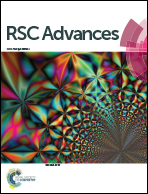Catalytic performance of a pyrolyzed graphene supported Fe–N–C composite and its application for acid direct methanol fuel cells†
Abstract
In this work, a graphene supported Fe–N–C composite catalyst, synthesized by pyrolysis of graphene oxide (GO), graphitic carbon nitride (g-C3N4), ferric chloride (FeCl3) and carbon black (Vulcan XC-72), was evaluated for oxygen reduction reaction (ORR) in acid media. The introduction of carbon black was to separate the graphene sheets to enhance the specific surface area and thus improve the catalytic activity of the catalyst. The experimental results showed that the composite catalyst could yield an average electron transfer number of 3.85 and its onset and half-wave potentials for acidic ORR were only 56 and 69 mV smaller than those of Pt/C (40 wt% Pt) catalyst, respectively. The as-prepared catalyst was applied in an acid direct methanol fuel cell as the cathode catalyst and a peak power density of 11.72 mW cm−2 at 30 °C was demonstrated when feeding the anode and cathode with a 1 M methanol solution and air, respectively, suggesting its promising application.



 Please wait while we load your content...
Please wait while we load your content...